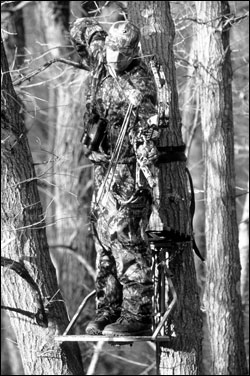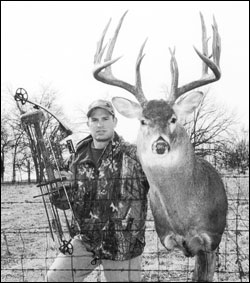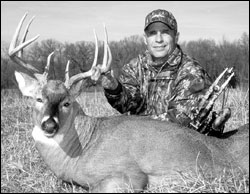October 28, 2010
Multiple Stand Sites And Stealthy Maneuvers Will Keep You In Deer This Season.
By Randy Templeton
 Be sure there's a direct line of sight to the vital area and the shot angle is not overly steep. If your stand is too high, then there's a very high probability the point of impact will be high as well. This one oversight could result in poor penetration and a slim to nothing blood trail to follow. |
I will never forget the call I received last year from my friend Bob. His voice was solemn and his words, downright depressing. Bob explained that he had two great stands set up: one sat near a doe bedding area, and the other hovered along the fringes of a soybean field. Both stands produced multiple opportunities to shoot a doe during the first week of October. However, having hunted nearly every succeeding day of the month, Bob hadn't seen any deer whatsoever, and fresh sign ceased to exist.
By the time our conversation played out, Bob had blamed his bad luck on the weather and the assumption that the deer must have gone completely nocturnal. My assessment was that Bob had simply burnt out the stands. Instead of waiting until the hard pre-rut, when bucks typically begin searching for the first estrus does, Bob started hunting the stands far too early!
Advertisement
Bob's bad luck seems like an all too familiar problem. Many bowhunters experience the same sequence, with deer sightings becoming fewer and stand strategies slowly turning south the longer we hunt. The cause stems from one of three things: over-hunting a stand, deer patterns having naturally changed, or the deer having simply made us! Two simple solutions can help eliminate these problems. The first is having fresh stands to hunt from during each phase of the season. The other is thorough scent control!
More Stands Are Better
Advertisement
It's a given fact that certain stand sites produce more opportunities in the early season, and others during the mid or late season. For these reasons, I have stands in place for each of the three (pre-rut, rut, post-rut) phases of the season to avoid burning out any before their time.
Based on my scouting, I may hang 25-30 stands each season. I'm sure it sounds like a lot of stands, but keep in mind they're normally spread out over several pieces of property and sometimes three different states. Depending upon terrain features and associated wind conditions, I'll hang at least two, and sometimes four, stands on the same property. I also keep handy one alternate, or backup stand, to hang on any given day. In doing so, I'm able to stay in the game and keep the stands fresh for longer periods of time.
The benefits of having multiple stand sets are obvious. I can move to a different stand as the season progresses and have a minimal impact on deer. When fresh sign deteriorates or sightings become fewer, don't assume anything. Identify the root cause and correct the problem.
The Right Time
Every year, I mount several stands that are risky to hunt even under ideal conditions. The time frame may need to be
perfect or the wind just right, to hunt these spots. I'd venture to say that over half the bucks I've shot in the past 30 years were taken from this type of setup. In addition, those bucks were taken the very first time the stand was hunted. That certainly was the case last year.
I'd hunted the area the year before and found it nearly impossible to get to and from the stand without getting busted. My only access at the time was cutting across a large pasture. However, an aerial photograph showed what appeared to be an old set of railroad tracks on the adjoining property. Funny thing is, the tracks had been torn out more than a decade ago and had since grown over. The newly found alternate route would make a prefect means for slipping into the area, but only under a northerly wind.
I setup the stand in early October, created a mock scrape, trimmed my shooting lanes and left the area. It was mid-November and the weatherman was predicting a cold front that Saturday, ideal conditions for the stand.
 Adam Crumrin of Martinsville, Illinois shot this dandy 14-point buck on November 4 last year. Adam patiently waited until the rut before slipping into the buck's bedding area with a climbing stand and arrowing the bruiser just a couple of hours later. The buck officially scored 1871Ú8 inches. |
An hour before sunrise, I made my way to the stand following the old railroad bed. Surprisingly, I made the trip without blowing out any deer. After freshening the scrape with a few drops of estrus scent, I climbed into the stand and settled in.
About 7:30 a.m., I happened to notice a doe walking across a CRP field, then a nice eight-point buck followed not far behind. A soft grunt from the Primos call caught the buck's attention and he picked up the pace.
Possibly a minute or so later, the buck leaped over the fence, and walked directly to the scrape and began working it over. Bringing my bow to full draw, I waited for the buck to stretch out his rut-swollen neck to lick the overhanging branch, and released the string. The broadhead blew through both sides of the chest cavity, sending the buck to his final resting place 100 yards away.
The Nose Knows!
Although nearly impossible to prove, it's been said that a whitetail's nose is a hundred times better than ours, and capable of detecting danger more than a couple hundred yards away. Knowing that, it's easy to understand how the smallest amount of human scent could change the whole course of a season.
In the early years, I banked heavily on good camouflage and my ability to play the wind effectively. In the past decade, however, I've focused more attention on developing sound scent control to beat a deer's nose.
I'd venture to say most blown opportunities result from one of two things: the deer approached from downwind or picked up human ground scent. If this is true, then eliminating both sources can help us gain the edge we need.
Total scent elimination may never be possible, but reducing it is certainly the first step in the right direction. Scent reduction programs begin with personal hygiene, including showering before every hunt with an unscented soap such as those by Wildlife Research Center, Nature's Essence or Hunter Specialties. The same goes for clothing. You'll want to keep your clothing scentless, and wash them in unscented detergents as well.
The greatest source of ground scent generally comes from our feet. One of the biggest mistakes I see hunters make is wearing boots with fabric or leather uppers, and onl
y a rubber tread sole. This type of boot design might be okay for spot and stalk hunts on elk or mule deer, but it simply doesn't cut the mustard for whitetails! The best way I know to control ground scent is to wear an all rubber boot, preferably knee-high, so you can stuff your pant legs inside.
Now that you're dressed to kill, you might consider spraying down all equipment and outerwear (boots too) with a scent neutralizer. If you really want to do this right, I might suggest an AC (activated charcoal) suit that's designed to adsorb and trap body odor, therefore preventing it from escaping and becoming airborne.
Alternate Routes
You can have a great stand location, but if you can't get there and back without bumping deer, then I'm guessing your homework wasn't done. I know of hunters who continually move stands and the root cause of detection normally results from their haphazard approach of getting there and back. In most instances, their plan consists of slipping in quietly to a stand and hoping for the best. This is not exactly the greatest strategic plan, by any means of measure!
 Some tree stands require ideal conditions to exist before they can be hunted. The author found an alternate route that allowed him to slip into location to shoot this nice 130-class buck the first day on stand. |
As part of my planning to determine the best stand locations, I typically start by asking myself a couple of simple questions. First, using the most obvious approach route, can I get to and from the stand both in the morning and evening undetected? Secondly, if I can't get there and back undetected, are there alternate routes that would allow me to? If I can answer both questions with legitimate answers, then the stand site becomes a likely candidate for both morning and evening hunting.
The One Shot Stand
As mentioned earlier, some stands are simply meant to be most productive during a specific time frame. I know a number of hunters who don't put up stands or even begin hunting hard until the rut gets underway. In most instances, these hunters have done their homework beforehand and know exactly where to hang a stand. When the ideal condition exists, they slip in with a stand, setup and kill a buck that same day. I call these the "one shot stands," mainly because they normally get one chance and after that the stand is worthless.
A good example of this was Adam Crumrin's experience last year while hunting in eastern Illinois. His ability to refrain from hunting an area until prime time paid off with a giant non-typical.
In September, Crumrin had spotted the huge buck while scouting and located the buck's core area, an oak ridge flat near a saddle crossing. From the ridge, the buck had a panoramic view in all directions, therefore slipping in to hang a stand wasn't an option. Instead, Adam decided to wait until the rut, when the stud buck would be most vulnerable and slip in with a climber and try to shoot the buck the same day.
As they say, good things come to those who wait. It was November 4, and Adam had seen bucks chasing does for a couple days. Even though the temperature hovered around the 70-degree mark, Adam climbed into his Scent-Lok suit, sprayed everything down with Scent Killer and headed up the ridge. Surprisingly, the savvy hunter arrived at the saddle rim without spooking any deer. Eyeballing a straight tree, he then scaled up 30 feet, a height he felt necessary to get above the immediate downwind scent stream.
A good part of the afternoon passed without Adam seeing a single deer. About 4:00 p.m. Adam decided to rattle a bit. After rattling one short sequence, he followed up with a couple grunts and doe bleats. About 10 minutes later a big buck appeared in the bottom, and shortly thereafter swaggered up the ridge. As the buck cleared the ridge crest at 35 yards, he cut off on a parallel trail. There was too much brush in the way to shoot, and the buck was soon out of range. Fortunately, Adam was able to turn the bruiser around with two bleats from a deer call. With only a small window to shoot, Adam came to full draw. When the buck stepped into the clearing, he released the string. The broadhead zipped through both sides of the quartering buck, causing him to whirl around and charge off. Mouthing a quick grunt momentarily caused the buck to stop and look back before walking a few more steps and going down."
The element of surprise is probably our greatest defense against the whitetails keen senses. Maintaining the element of surprise requires extra effort to keep stands fresh and the hunting area scent free. Follow a few of the aforementioned tips and I'm quite confident you'll not only see more deer, but also have more close range opportunities! Good luck and happy hunting!
